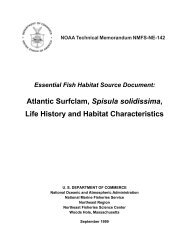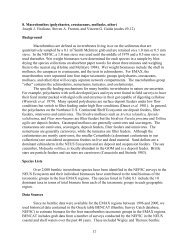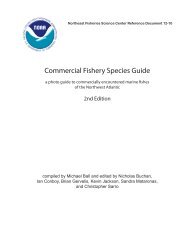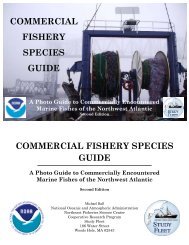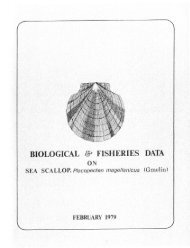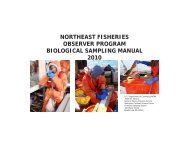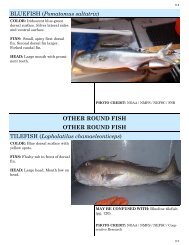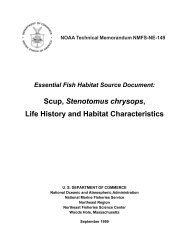Albatross IV - Northeast Fisheries Science Center - NOAA
Albatross IV - Northeast Fisheries Science Center - NOAA
Albatross IV - Northeast Fisheries Science Center - NOAA
You also want an ePaper? Increase the reach of your titles
YUMPU automatically turns print PDFs into web optimized ePapers that Google loves.
Administration. <strong>Albatross</strong> <strong>IV</strong> has taken multiple trips to the yards to receive a number of<br />
physical modifications. These modifications enhanced the ship’s ability to complete her<br />
mission, and also provided a more welcoming and hospitable environment for both<br />
scientists and crew. The largest modification was the enclosure of the upper deck and<br />
winch controls in the mid-1970s. This change led to the creation of today’s computer<br />
room, ET shop, ship’s office and lounge.<br />
<strong>Albatross</strong> <strong>IV</strong> has supported many different NEFSC missions, but her bread and<br />
butter has always been the Bottom Trawl Survey. Now, after two years of preparation and<br />
calibration work, the survey is ready to be turned over to <strong>NOAA</strong> Ship Henry B. Bigelow.<br />
Thus ends of a long and illustrious line of ships that have carried the name <strong>Albatross</strong>.<br />
In 1883 when US <strong>Fisheries</strong> Commission Steamer <strong>Albatross</strong> was launched, she too<br />
was on the cutting edge of technology in both nautical and scientific frontiers. She sailed<br />
along not only the East Coast of the US, but down the entire coast of South America,<br />
through the Straight of Magellan, and north towards the Galapagos. She continued her<br />
survey around the Pacific with stops in San Francisco, Anchorage, Honolulu, and<br />
throughout the Philippines and Japan. After a brief stint in the Navy during the Spanish-<br />
American War, she returned to Woods Hole to sail in the service of fisheries science<br />
where eighty-eight years and three weeks ago she was decommissioned at the same<br />
location where the heir to her name, <strong>Albatross</strong> <strong>IV</strong>, will undergo the same ceremony today.<br />
In between these two illustrious ships were <strong>Albatross</strong> II and <strong>Albatross</strong> III.<br />
Unfortunately, neither of these ships had the chance to serve their nation for as long a<br />
period as their descendent, or in such grand and adventurous assignments as their<br />
predecessor.<br />
This brings us to this most somber of days. Truly, with the conclusion of this<br />
ceremony we will see the end of an era. The <strong>Albatross</strong> line of fisheries research vessels<br />
will always be remembered throughout the annals of scientific history. <strong>Albatross</strong> <strong>IV</strong> alone<br />
has contributed over 17,166 samples to the Smithsonian, Yale and Harvard University<br />
collections, in addition to 182,355 samples given to said collections from her<br />
predecessors. Much of the documentation of <strong>Albatross</strong> <strong>IV</strong> and even portions of her<br />
physical being, will be preserved at various locations including the <strong>Northeast</strong> <strong>Fisheries</strong><br />
<strong>Science</strong> <strong>Center</strong>, Marine Operations <strong>Center</strong> – Atlantic, the National Archives, the<br />
Smithsonian Institution, and the <strong>NOAA</strong> Library.<br />
While the preservation of her operational history and the measurement of her<br />
accomplishments as a whole are important, none of them can compare to the emotional<br />
bond established between <strong>Albatross</strong> <strong>IV</strong> and her loving crew and scientists. Through the<br />
years, <strong>Albatross</strong> <strong>IV</strong> has touched many lives in a multitude of ways: loves-hates,<br />
marriages-divorces, births-deaths, hirings-firings and so many friendships that have<br />
endured far past the boundaries of the ship itself; friendships as limitless as the ocean<br />
upon which she sails. Yes, this mass of steel, wires, machinery and fluids has been<br />
pivotal in many person’s lives.<br />
The tradition stands since the dawn of seafaring to refer to a ship in the first<br />
person, as if she was an entity unto herself. I do not believe that it is the ship herself that<br />
becomes her entity but the people who sail her. All of their combined efforts come<br />
together in order to bring her to life, to fire off her mains, to steer the intended course, to<br />
set the net off her stern, to process her catch for the advancement of science; oh yes, as<br />
she sails off into history all who have sailed aboard her can rest assured that they are as<br />
8




